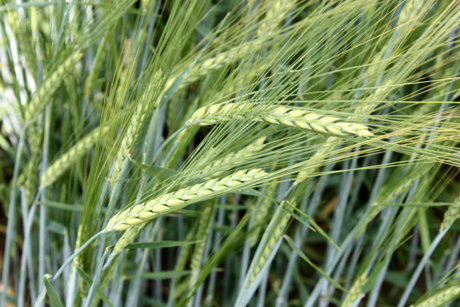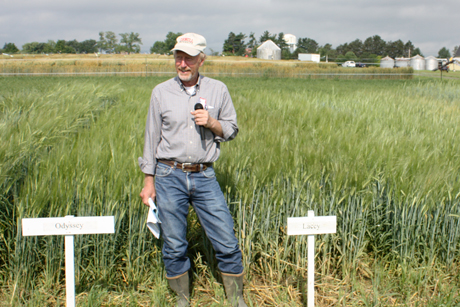Interest brews in reviving malted barley crop
By Stacey Shackford


The farm brewery law adopted last year by the New York State Legislature is creating new demand for an old crop: malted barley.
In return for sourcing at least 25 percent of their hops and 40 percent of all other ingredients from New York farms, brewers can receive a lower cost, simplified license. In 10 years, that ratio will increase incrementally to 90 percent.
Farmers eager to seize the opportunity have turned to Cornell plant breeder Mark Sorrells for advice about how to start – a recent rainy field day at Musgrave Research Farm in Aurora attracted nearly 50 farmers, and an eclectic mix of farmers, millers, brewers, distillers and malt house owners attended another Hudson Valley event last week.
But Sorrells, professor of plant breeding, doesn’t have much information to share yet. Hampered by budget cuts, he can’t afford to start breeding his own regionally adapted varieties, so he’s testing existing varieties, most bred for Europe or the Midwest. Of the 40 varieties he’s tested so far over the past year, three winter malting barleys have stood out as having potential for the Northeast.
“Usually I don’t make recommendations until we have at least three years of data, as every year is different, especially in New York. But there are so many people out there desperate for information that we are going to make some preliminary recommendations after this year,” Sorrells said. “The New York State Legislature saw the opportunity to develop an industry, but they didn’t foresee the lack of information on malting varieties in New York.”
The 119 breweries in New York used an estimated 32 million pounds of malt in 2012, and the state’s existing five malt houses are processing about a ton of malted barley a week – which barely meets the needs of a single small brewery.
“We have nowhere near the malting volume we need to service all the local brewers; we could probably use 10 times that much,” Sorrells said.
So what is he telling farmers?
Don’t start growing malting barley until you have a relationship with a buyer, and know that growing malting barley is different than growing feed barley for livestock.
“It’s like a completely different grain; the varieties are different, management is different, harvesting is different, marketing is different,” Sorrells said. “People interested in getting involved with malting barley have a lot of things to learn.” For example, such farmers need to apply less nitrogen fertilizer than usual, harvest on time and dry at a proper temperature.
In addition to Sorrells’ field trials, other researchers at Cornell – including plant pathologist Gary Bergstrom and extension specialists Bill Verbeten, Mike Stanyard and Kevin Ganoe – are investigating fertilizer management, soil conditions, weed, insect and disease control.
The so-called “vomitoxin,” which occurs when plants are infested with fusarium head blight, is one of the diseases believed to have driven barley out of production in New York decades ago, when grains and hops once dominated the landscape.
Despite the challenges, premium prices might make the venture worthwhile for some farmers, Sorrells said. Other things could also mitigate the risks. It’s possible to squeeze two crops into each year, planting summer crops after the winter varieties are harvested. And those growing organic grains have a potential backup should their barley fail malting standards: the emerging market for organic livestock feed.
Stacey Shackford is staff writer for the College of Agriculture and Life Sciences.
Media Contact
Get Cornell news delivered right to your inbox.
Subscribe